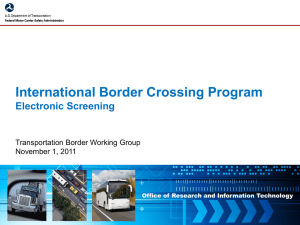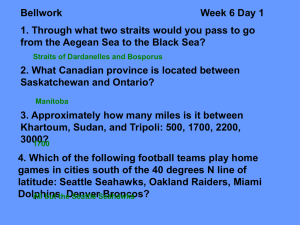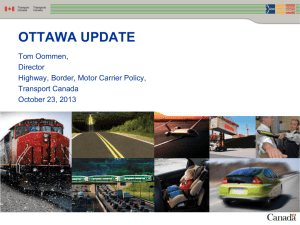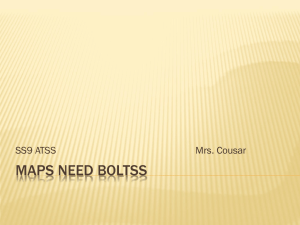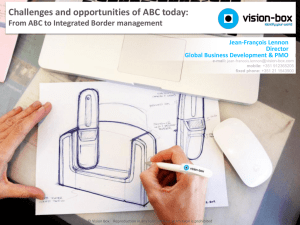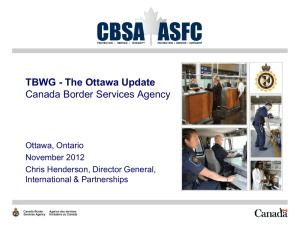What is ITS
advertisement
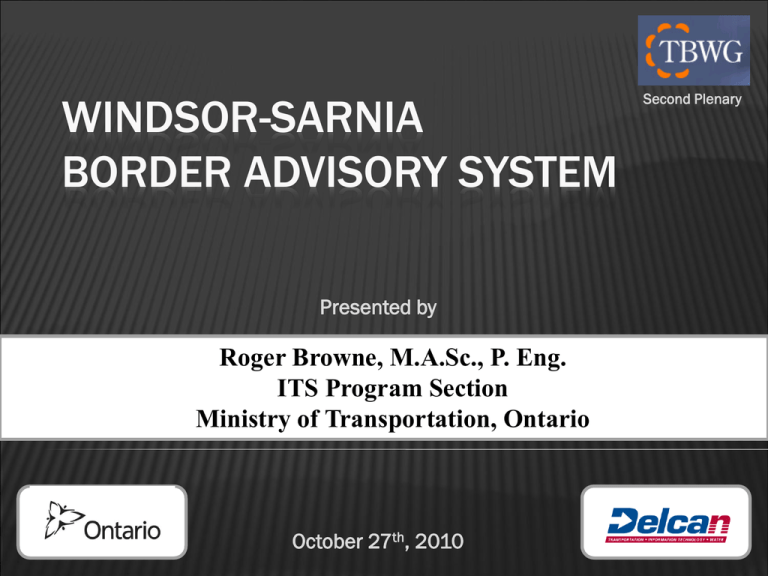
WINDSOR-SARNIA BORDER ADVISORY SYSTEM Presented by Roger Browne, M.A.Sc., P. Eng. ITS Program Section Ministry of Transportation, Ontario October 27th, 2010 Second Plenary OUTLINE Background - Project Scope Key Issues and Challenges Project Status and Next Steps Questions Transportation Border Working Group : Oct, 2010 BORDER ADVISORY SYSTEM BACKGROUND-PROJECT SCOPE 3 BACKGROUND Under the Intelligent Border Crossing study, a vision was established that identified three key areas of focus: Traffic Management and Operations Advanced Traveler Information Public/Private Sector Needs VISION – THREE KEY ASPECTS [1] Traffic Management and Operations Providing real-time information en route ITS to facilitate improved safety and efficiency at the border approaches ITS to aid motorists and commercial vehicles in decision-making 5 VISION – THREE KEY ASPECTS [2] Advance Traveler Information (ATI) Providing information to motorists and commercial vehicle operators via the Internet Combination of border wait-time plus traffic conditions along the route Intended for pre-trip planning purposes Provides real-time, historic log and prediction of traffic conditions and border wait-times 6 VISION – THREE KEY ASPECTS [3] Additional Public/Private Sector Needs Similar to ATI however, customized, value-added information Real-time and historic information of significant value to: Border crossing authorities CBP and CBSA Commercial Vehicle Operators (CVO) Border Crossing Operators – Windsor-Detroit Tunnel, Blue Water Bridge, Ambassador Bridge, etc. 7 PROJECT SCOPE – BORDER ADVISORY SYSTEM Traffic Management and Operations System to provide border wait-time information for motorists and commercial vehicles en route Current Border Delay Ambassador Bridge Detroit Windsor Tunnel 10 MIN 8 MIN 8 OTHER BORDER ADVISORY SYSTEM WARRANTS Border Advisory System is a key piece to meeting other requirements Advanced Traveller Information Information generated by system can be published on the web for pre-trip planning purposes Balance border traffic demands on provincial level Public/Private Sector Needs Border delay combined with traffic delays to estimate travel times along selected routes Information generated to be provided directly to CBP or CVOs 9 Transportation Border Working Group : Oct, 2010 KEY ISSUES AND CHALLENGES 10 ISSUES AND CHALLENGES Project presents many challenges both logistical and technical Logistical What information and where? Support from border crossing operators Technical Algorithm to determine border wait-time Technology to collect data 11 WHAT INFORMATION AND WHERE? Concerns regarding the value in providing detailed information so far upstream Addressed via: Project team asks the question, “If I were a motorist or a commercial vehicle traversing this route, what information am I really looking for and where?” Resolution of information to become more detailed the closer you get Maybe need to supplement with real-time information regarding travel times to get to Windsor or Sarnia 12 BORDER DELAY INFORMATION (WHERE) (CONCEPTUAL MOCK-UP OF LOCATIONS BASED ON REST STATIONS) BORDER ADVISORY SIGN (WHAT INFO) CURRENT BORDER WAIT-TIMES (mins) CARS Windsor-Detroit Tunnel 5-10 0-5 Ambassador Bridge 5-10 0-5 TRUCKS 15-20 Detroit-River 5-10 Int’l Crossing 0-5 15-20 TRUCKS 0-5 0-5 BORDER CROSSING OPERATORS Concern that the information provided may inadvertently cause a loss in revenue Addressed via: Generally motorists don’t divert from their set plan; commercial vehicles generally cannot divert from programmed crossing Independent, unbiased historic information can be used for business forecasting Becoming active stakeholder could result in new potential revenue stream 15 ALGORITHM DEVELOPMENT Mathematical models or algorithms are required to take traffic data and calculate or predict border wait-times Freeway vs Arterial Approach Freeway to Inspection Lanes – Straight forward Arterials to Inspection Lanes – Far more complex 16 ALGORITHM PRINCIPLE QUEUE LENGTH SERVICE RATE BORDER WAIT-TIME Service Rate = 5 veh/min; Queue Length = 10 vehicles; Therefore, Border-Wait-Time = 2 mins FREEWAY APPROACHES TO BORDER CROSSING Traffic queues from primary inspection lanes directly onto freeway Freeway spillback is the only queue/wait-time that needs to be measured No other constraints on freeway 18 ARTERIAL APPROACHES TO BORDER CROSSING Traffic queues from primary inspection lanes onto one or more municipal streets Queuing also independently caused by high traffic volumes at signalized intersections Driveways and other side-friction can also impose further queuing and delays 19 TECHNOLOGY TO COLLECT DATA Technology must be non-intrusive Not possible to get inductive loops on bridges or tunnels given potential traffic impacts during installation and maintenance Technology must cater to sensitivities Video-based systems may not be permitted due to current or future re-hashed security concerns Probe-based information must be anonymous 20 Transportation Border Working Group : Oct, 2010 PROJECT STATUS AND RECENT FINDINGS 21 PROJECT STATUS Official kick-off meeting held in September Project Information Briefing Sessions held with Blue Water Bridge and Windsor-Detroit Tunnel border crossing operators Significant progress made with respect to laying out the approach and tackling the issues 22 BORDER WAIT-TIME MEASUREMENT APPROACH Determine what information required and location Determine data needs to generate this information Develop mathematical algorithm to generate this information from data collected Select and test technologies capable of providing the data required Compare border wait-time calculated against ground truth Modify or calibrate algorithm based on findings 23 TRAFFIC ENGINEERING PERSPECTIVE Considering whether or not there is an overload of information to be provided Consideration being given to whether or not there is a need to have additional information in the City of Windsor itself Possible Scenario INFORMATION FOR MOTORISTS Ambassador Bridge Border Wait-Times Windsor-Detroit Tunnel Border Wait-Times Travel Time to US via Ouellette Travel Time to US via Hwy 3 Border Delay + Travel Times 25 GROUND TRUTH INFORMATION Original Delcan proposal calls for calibration runs to confirm operation of algorithm Now considering Bluetooth readers to establish database of ‘ground truth’ information for comparison and calibration of algorithm 26 DATA COLLECTION TECHNOLOGY Concerns over microwave given inaccuracy of readings at lower speeds Consideration being narrowed down to: Microloops installed under bridge structures where it is easy to install and maintain without affecting traffic Bluetooth Readers with some form of prediction model based on mapping current conditions with historic data Smart phone GPS tracking application whereby an APP is developed and motorists volunteer their information in exchange for detailed traffic information on a whole 27 NEXT STEPS Sarnia Approach Currently negotiating arrangement with Blue Water Bridge to have additional micro-loop detection added to their ongoing contract With detection installed, algorithm developed for freeway-to-inspection lane can now be tested and calibrated Windsor Approach Currently working on concept of operations and strategy for messaging Developing detailed plan to gain support from WindsorDetroit tunnel operator 28 QUESTIONS 29 FOR MORE INFORMATION Roger Browne, M.A.Sc., P. Eng. Senior Project Engineer ITS Program Section Ministry of Transportation, Ontario Roger.Browne@ontario.ca 30


